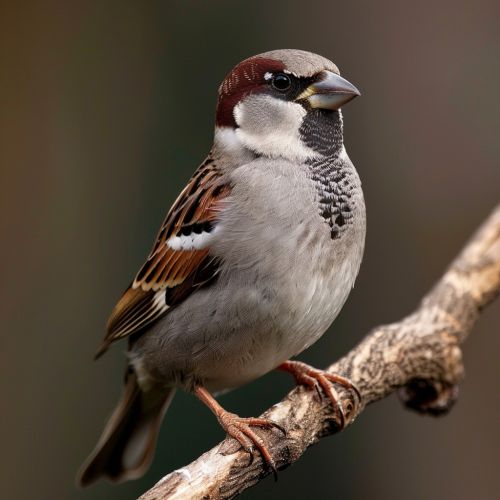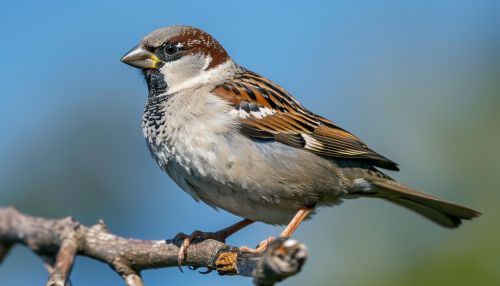Sparrow
Introduction
The sparrow is a small passerine bird belonging to the family Passeridae. Sparrows are found across the globe, with the house sparrow (Passer domesticus) being one of the most widespread bird species. These birds are often associated with human habitation and are known for their adaptability to various environments. This article delves into the biology, behavior, ecology, and cultural significance of sparrows, providing a comprehensive overview for those interested in ornithology and avian studies.
Taxonomy and Classification
Sparrows belong to the order Passeriformes, which is the largest order of birds and includes over half of all bird species. Within this order, sparrows are part of the family Passeridae. The family Passeridae is divided into several genera, with the genus Passer being the most well-known. Other genera include Petronia, Gymnoris, and Carpospiza.
Species Diversity
There are approximately 43 species of sparrows, with the house sparrow being the most recognized. Other notable species include the Eurasian tree sparrow (Passer montanus), the Spanish sparrow (Passer hispaniolensis), and the Cape sparrow (Passer melanurus). Each species exhibits unique adaptations to their specific habitats, ranging from urban areas to deserts and forests.
Morphology and Anatomy
Sparrows are small birds, typically measuring between 12 to 18 centimeters in length. They have stout bodies, short tails, and strong, conical beaks adapted for seed eating. The plumage of sparrows is generally brown, gray, and white, providing effective camouflage in their natural habitats.
Skeletal Structure
The skeletal structure of sparrows is lightweight yet robust, allowing for agile flight and efficient foraging. Their bones are pneumatic, meaning they are filled with air spaces that reduce weight without compromising strength. The sternum, or breastbone, is keeled to support the attachment of powerful flight muscles.
Musculature
Sparrows possess well-developed pectoral muscles that enable sustained flight. These muscles are anchored to the keeled sternum, providing the necessary force for wing flapping. Additionally, sparrows have strong leg muscles that facilitate perching and hopping.
Behavior and Ecology
Sparrows are highly social birds, often forming flocks outside the breeding season. Their behavior is characterized by complex vocalizations, territoriality, and intricate mating rituals.
Vocalizations
Sparrows communicate through a variety of calls and songs. These vocalizations serve multiple purposes, including attracting mates, defending territories, and signaling alarm. The house sparrow, for example, has a repertoire of chirps, cheeps, and trills that convey different messages.
Feeding Habits
Sparrows are primarily granivorous, feeding on seeds and grains. However, they are opportunistic feeders and will consume insects, fruits, and human food scraps when available. Their strong beaks are well-suited for cracking open seeds, and they exhibit a behavior known as "gaping," where they pry open seed husks with their beaks.


Breeding and Nesting
Sparrows are monogamous, forming pair bonds that last for a breeding season or longer. They typically nest in cavities, such as tree holes, building eaves, and nest boxes. The female lays a clutch of 3 to 7 eggs, which both parents incubate. The chicks hatch after about two weeks and are fed by both parents until they fledge.
Habitat and Distribution
Sparrows are highly adaptable and can thrive in a variety of habitats. They are found in urban areas, agricultural fields, grasslands, and forests. The house sparrow, in particular, has a global distribution, having been introduced to many regions outside its native range.
Urban Adaptation
The house sparrow's success in urban environments is attributed to its ability to exploit human resources. They nest in buildings, feed on food scraps, and use artificial structures for perching. This adaptability has allowed them to become one of the most common bird species in cities worldwide.
Conservation Status
While some sparrow species are abundant, others face conservation challenges. Habitat loss, pesticide use, and competition with invasive species have led to declines in certain populations. Conservation efforts focus on habitat restoration, monitoring populations, and mitigating threats.
Cultural Significance
Sparrows have held various symbolic meanings in different cultures throughout history. In literature, art, and folklore, they are often associated with themes of simplicity, freedom, and resilience.
Literature and Art
Sparrows have been depicted in numerous works of literature and art. In Aesop's fables, they are portrayed as clever and resourceful creatures. In Chinese culture, sparrows symbolize happiness and marital fidelity, often appearing in traditional paintings and poetry.
Folklore and Mythology
In European folklore, sparrows are sometimes seen as omens or messengers. For example, in some traditions, a sparrow flying into a house is considered a sign of impending change. In ancient Egyptian mythology, sparrows were believed to carry the souls of the deceased to the afterlife.
Research and Studies
Sparrows have been the subject of extensive scientific research, contributing to our understanding of avian biology, behavior, and ecology.
Behavioral Studies
Research on sparrow behavior has provided insights into social structures, communication, and mating systems. Studies on vocalizations have revealed the complexity of their communication and the role of learning in song development.
Ecological Impact
Sparrows play a significant role in their ecosystems as seed dispersers and insect predators. Their feeding habits can influence plant community dynamics and pest populations. Additionally, they serve as prey for various predators, including birds of prey, mammals, and reptiles.
